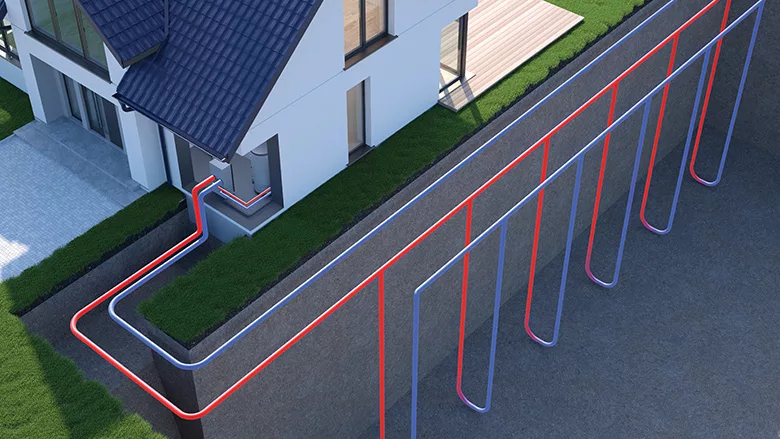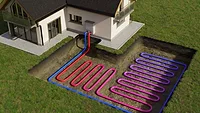Geothermal Heat Pumps: A Transformative Opportunity for Industry and Community

Photo credit: Kange Studio via Getty Images
The demand for geothermal heat pumps (GHP) is soaring as the world embraces renewable energy solutions. This surge is driven by federal and state incentives, energy efficiency, and the need to reduce carbon emissions. However, with increased demand there is a significant challenge: the need to develop a skilled workforce capable of installing and maintaining these systems at scale. Heating, ventilation, and air conditioning (HVAC) professionals, drillers, ground-loop contractors, system designers, and financial institutions are all poised to benefit, but they must overcome several workforce development challenges.
Key Components of Geothermal Heat Pump (GHP) Systems: Ensuring Accurate Terminology and Optimal Performance
Properly labeling and understanding the components of a GHP system ensures clarity, especially as this technology gains wider adoption. A GHP system consists of two primary elements: a ground source heat pump and a ground heat ex-changer.
The ground source heat pump is that system’s central component, delivering superior efficiency by harnessing the Earth's stable temperatures to meet a building's indoor heating and cooling demands. Such efficiency by a ground source pump is achieved through its synergy with the ground heat ex-changer, a critical element that maximizes energy transfer. The ground heat exchanger efficiently extracts or rejects thermal energy through a network of horizontal or vertical ground loops, enabling the heat pump to operate at significantly higher performance levels than conventional systems. This combination ensures year-round energy savings and consistent comfort, making GHPs a top choice for sustainable, efficient climate control.
For residential installations, vertical ground loops are typically installed to a depth of 300 to 350 feet per borehole. In commercial applications, boreholes generally range from 500 to 1,000 feet, depending on the required capacity, the site's thermal properties, and the available land area. Such ground loops are critical to the system's performance and durability, as they interact directly with the Earth’s stable temperatures to provide consistent heating and cooling year-round.
The standard that governs the installation of geothermal heat pump systems is ANSI/CSA/IGSHPA C448. The manual forms the foundation of the training programs developed and implemented under the purview of the International Ground Source Heat Pump Association (IGSHPA). These standards ensure that geothermal systems are designed and installed precisely to maximize efficiency and longevity. Properly trained professionals, including HVAC technicians and drillers, play a crucial role in the success of these installations, and their training aligns with this standard to guarantee the delivery of high-quality, reliable GHP systems. This adherence to best practices ensures optimal system performance and strengthens the broader effort to cultivate a competent and prepared workforce in the geothermal industry.
The Workforce Development Challenge: Meeting Increased Demand
The rapid growth of geothermal projects has highlighted a major bottleneck: the shortage of skilled labor. Unlike traditional HVAC systems, GHPs require specialized skills in drilling, loop field design, system integration, and energy modeling. This increased demand is exceeding the capacity of the existing workforce.
HVAC professionals, for example, have traditionally focused on air-based heating and cooling systems. Transitioning to geothermal heating and cooling technology involves mastering new concepts, such as ground-source heat exchange, loop field installation, and integrating GHP systems into existing building envelopes. Similarly, drillers who are accustomed to more traditional drilling applications must adapt their skills to focus on geothermal loop installation, which requires precision, technical understanding, and compliance with environmental regulations.
The HVAC industry is also seeing a significant rise in the demand for system designers, particularly in the commercial sector, where complex, large-scale GHP systems require advanced modeling and design. Without properly trained professionals in these fields, developers may struggle to implement GHP systems efficiently and cost-effectively.
Opportunities for HVAC Professionals, Drillers, and Entrepreneurs
Despite these challenges, the workforce development needs within the geothermal sector present unprecedented opportunities. HVAC professionals who expand their skill sets to include GHP systems will increase their value and ensure long-term relevance in a rapidly changing industry. This transition provides a pathway for career advancement and diversification, particularly as traditional HVAC technologies face increased regulatory pressures and energy efficiency mandates.
The growth in GHP projects creates a new, lucrative market for drillers and ground-loop contractors. Companies specializing in geothermal drilling and loop installation are already in high demand, and that demand is only set to grow as more developers and homeowners opt for geothermal solutions. For drillers who traditionally focus on other industries, entering the geothermal space represents a chance to diversify and establish a foothold in an expanding market.
Entrepreneurs, too, are presented with significant opportunities. Whether starting a geothermal drilling business, developing new technology for more efficient loop installation, or offering specialized design services, there is a growing need for innovative solutions that make GHP installations more cost-effective and scalable. Entrepreneurs who can solve key challenges in installation speed, cost reduction, and system performance will find a market hungry for their expertise.

Photo credit: Brock Yordy
The Role of Financial Institutions and Lending Organizations
As developers increasingly consider GHPs, financial institutions and lending organizations have an essential role to play. Financing these projects, particularly for residential and low-to-moderate-income (LMI) multi-family housing developments, can unlock the potential for GHPs in sectors that may have historically been overlooked.
Property assessed clean energy (PACE) programs is an innovative mechanism for financing energy efficiency and renewable energy improvements on private property. PACE programs and other financing mechanisms can provide the capital necessary for developers and property owners to install geothermal systems without significant upfront costs. For LMI projects, this is particularly important, as financing options allow affordable housing developers to invest in energy-efficient systems that provide long-term savings for tenants. These systems also contribute to improved living conditions, reducing energy costs and environmental impacts for communities with limited access to such benefits.
Lending organizations that recognize the long-term financial stability and energy cost savings associated with GHPs will have a competitive edge in financing projects supporting sustainability goals and community development.
Workforce Development Initiatives: Meeting the Challenge
Several organizations are building innovative workforce development programs to meet the growing demand for geothermal expertise. The non-profit organization Home Energy Efficiency Team (HEET) has been at the forefront of creating programs that train workers for careers in renewable energy, including geothermal. HEET focuses on building a skilled workforce while ensuring workers from diverse backgrounds can access training and job opportunities in the renewable energy sector.
Similarly, industry associations such as IGSHPA and GeoExchange are working to expand training programs for professionals across the geothermal sector. IGSHPA, for example, offers certification programs for drillers, installers, and designers, ensuring workers have the skills to meet the technical challenges of GHP installations. These certifications are increasingly seen as essential credentials for contractors and designers, helping to maintain high standards of quality and performance across the industry.
The newly formed Geothermal Drillers Association (GDA) has emerged as another key player in addressing the workforce challenge. This organization focuses on supporting drillers transitioning into the geothermal market, offering specialized training, resources, and advocacy. As the demand for geothermal installations continues to rise, the GDA is helping to ensure that skilled labor is available to meet the industry's needs.
Organized Labor: A Critical Contributor to Workforce Development
Organized labor is essential in the geothermal industry’s workforce development efforts. Labor unions, particularly those in the construction and HVAC sectors, have long been involved in training and certification programs that ensure workers are equipped with the necessary skills for emerging industries. As GHP installations require highly specialized knowledge, unions have provided training programs covering everything from loop installation to system maintenance.
Through apprenticeship programs, unions ensure that workers are trained in the technical aspects of GHP systems and are also aware of industry best practices, safety protocols, and environmental considerations. This ensures consistent quality across installations, which is critical for the long-term success and growth of the geothermal industry.

Photo credit: Brock Yordy
Expanding the Impact: GHPs in LMI Multi-Family Housing
The potential for GHPs in LMI multi-family housing is immense. Historically, LMI housing developments have struggled to adopt cutting-edge energy technologies due to the high upfront costs. However, the availability of federal, state, and local incentives, combined with innovative financing options, has opened the door for LMI housing developers to invest in GHP systems.
For LMI tenants, GHP systems offer several benefits, including lower energy bills and improved indoor air quality. These savings can make a significant difference for families living on tight budgets, helping to reduce the financial burden of energy costs while contributing to a healthier living environment. Moreover, GHP systems provide a long-term solution for reducing a building’s environmental footprint, supporting broader community sustainability and resilience goals.
The Inflation Reduction Act’s (IRA) provision allowing non-profits and tax-exempt organizations to receive direct payments for tax credits is particularly beneficial for LMI multi-family housing projects. By enabling non-profit housing developers to access the same financial incentives as for-profit companies, the IRA makes GHP systems more affordable and accessible for LMI housing projects.
The Time Is Now for Geothermal
GHPs offer unparalleled opportunities for developers, workforce professionals, and communities alike. With strong federal and state incentives, the financial case for GHPs has never been stronger. At the same time, the demand for skilled labor in the geothermal industry presents significant career and business opportunities for HVAC professionals, drillers, system designers, and entrepreneurs.
By investing in workforce development and embracing the potential of GHPs in all sectors—from luxury commercial developments to LMI multi-family housing—the industry can increase in scale to meet the growing demand while creating high-quality jobs and sustainable communities.
A Unified Effort: Industry and Labor Driving the Geothermal Revolution
The geothermal revolution is not just about technology; it is about people. Through the efforts of organizations like HEET, IGSHPA, GeoExchange, and the GDA, the industry is preparing the next generation of workers to take on the challenges of installing and maintaining GHP systems. Organized labor, too, is playing an indispensable role in ensuring that workers are trained and ready to meet the demands of this rapidly growing industry.
The benefits are clear: reduced energy costs, improved environmental outcomes, energy avoidance that creates less stress on the electrical grid, and a sustainable path forward for developers and communities. The future of geothermal is bright, and now is the time to act. Developers who seize this moment will position themselves for financial success and contribute to a cleaner, more sustainable future for all.
The opportunities for GHPs are vast—embrace them today.
Looking for a reprint of this article?
From high-res PDFs to custom plaques, order your copy today!




